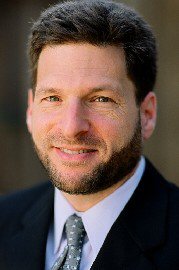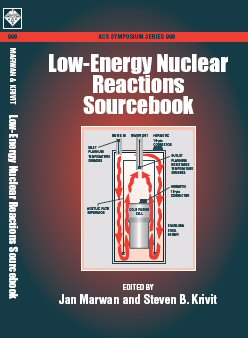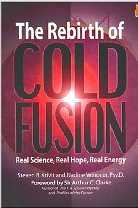Pages: 300
Publisher: American Chemical Society
Year: 2010
ISBN: 0841224544
ISBN: 978-0841224544
In 1989, the subject was announced with great fanfare, to the chagrin of many people in the science community. However, the significant claim of its discoverers, Martin Fleischmann and Stanley Pons, excess heat without harmful neutron emissions or strong gamma radiation, involving electrochemical cells using heavy water and palladium, has held strong.
In recent years, LENR, within the field of condensed matter nuclear science, has begun to attract widespread attention and is regarded as a potential alternative and renewable energy source to confront climate change and energy scarcity. The aim of the research is to collect experimental findings for LENR in order to present reasonable explanations and a conclusive theoretical and practical working model.
The goal of the field is directed toward the fabrication of LENR devices with unique commercial potential demonstrating an alternative energy source that does not produce greenhouse gases, long-lived radiation or strong prompt radiation. The idea of LENR has led to endless discussions about the kinetic impossibility of intense nuclear reactions with high coulomb barrier potential. However, recent theoretical work may soon shed light on this mystery.
Understanding this process is one of the most challenging and perhaps important issues in the scientific world. This book includes previously unpublished studies, new and controversial theories to approach LENR with access to new sources and experimental results. The book offers insight into this controversial subject and will help readers re-evaluate their perspective on LENR as a possible alternative energy source.
Pages: 420
Year: 2008
ISBN: 0841269661
ISBN: 978-0841269668
Websites: newenergytimes.com/Books/2008-LENR-Sourcebook/LENR-Sourcebook.htm www.newenergytimes.com
In 1989, the subject was announced with great fanfare, to the chagrin of many people in the science community. However, the significant claim of its discoverers, Martin Fleischmann and Stanley Pons, excess heat without harmful neutron emissions or strong gamma radiation, involving electrochemical cells using heavy water and palladium, has held strong.
In recent years, LENR, within the field of condensed matter nuclear science, has begun to attract widespread attention and is regarded as a potential alternative and renewable energy source to confront climate change and energy scarcity. The aim of the research is to collect experimental findings for LENR in order to present reasonable explanations and a conclusive theoretical and practical working model.
The goal of the field is directed toward the fabrication of LENR devices with unique commercial potential demonstrating an alternative energy source that does not produce greenhouse gases, long-lived radiation or strong prompt radiation. The idea of LENR has led to endless discussions about the kinetic impossibility of intense nuclear reactions with high coulomb barrier potential. However, recent theoretical work may soon shed light on this mystery.
Understanding this process is one of the most challenging and perhaps important issues in the scientific world. This book includes previously unpublished studies, new and controversial theories to approach LENR with access to new sources and experimental results. The book offers insight into this controversial subject and will help readers re-evaluate their perspective on LENR for a possible alternative energy source.
Reviews:
- Release of Low-Energy Nuclear Reactions Sourcebook and More Thoughts on ICCF1 by Scott Chubb, Infinite Energy, V82, p. 50 (Nov/Dec 2008).
- CMNS/LENR Update, August 18, 2008
Pages: 320
Publisher: Pacific Oaks Press
Year: 2004
ISBN: 0976054582
ISBN: 978-0976054580
Websites: www.newenergytimes.com
They were real scientists, credentialed, with long and respectable careers. They employed the same instrumentation and methodologies used in "normal" science. According to them, there was strong evidence for a new source of clean nuclear (no, this is not an oxymoron) energy. At first, it didn't make sense why their research had been ignored. As I dug deeper, the complex scientific and human drama, perhaps the greatest of our time, revealed itself.
The goal of this book is to provide everything you might want to know about the first period of cold fusion's history. What happened? Why? Who was responsible for the successes? The failures? Who knew what and when did they know it? The book is written for the nonscientific reader and provides a unique glimpse into the inner and sometimes ugly process of new science. You'll learn that scientists can be surprisingly unscientific when threatened with new ideas that challenge their funding, stature and careers. You will see how science really works - or doesn't.
The opponents of cold fusion (now known technically as low energy nuclear reactions) tried their hardest to bury this newborn science, but they failed. Cold fusion is a triumph of the scientific method, and an expos? of science politics. Its discoverers, Martin Fleischmann and Stanley Pons, were not forced to recant under threat of death, but their treatment by the establishment was not unlike that of Galileo Galilei by his tormentors.
In the heat of the battle, Pons said, "It appears that the people who would benefit most by this work being discredited have taken the initiative to cause us great difficulty ... They might cause us difficulty, but they will not stop the science.'' Pons was right; real science cannot be killed -- delayed, yes, but not forever. Fleischmann and Pons were ousted from science but many courageous and dedicated researchers around the world carried on where they left off and kept the research alive.
In the book's introduction, futurist Sir Arthur C. Clarke declares: "An unbiased reader finishing this book will sense that something strange and wonderful is happening at the 'fringes' of science." What will be the future of cold fusion? That is one of the big remaining mysteries. What is for certain is that the story begins here.
-Steven Krivit





